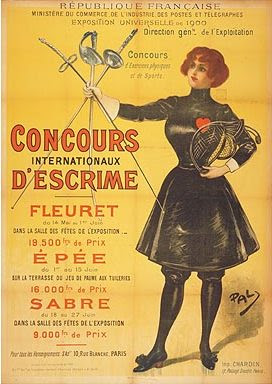 1900 Paris, France (II Olympaid)
1900 Paris, France (II Olympaid)
During the 1900 Universal Exhibition, certain events of international physical exercise and sports competitions were recognised as Olympic and made up the programme of the second modern Olympic Games. Several posters were created-athletics, rowing, cycling, fencing and gymnastics. Here, a female fencer holding in her right hand the three traditional weapons- foil, sword and sabre. However, it should be noted that women did not compete in the fencing competitions until 1924.

1904 St. Louis, USA (III Olympaid)
It shows a view of the host city, enhanced by the use of a "fish's eye" effect. It is the reproduction of the cover of the programme of the Games. 1908 London, Great Britain (IV Olympiad)
1908 London, Great Britain (IV Olympiad)
It represents the Olympic stadium in Shepherd's Bush. Behind the high jump, in the centre, the swimming pool and cinder track. 1912 Stockholm, Sweden (V Olympaid)
1912 Stockholm, Sweden (V Olympaid)
It represents the parade of nations, each athlete carrying a twirling flag and all going towards a common goal- the Olympic Games. The nudity of the athletes was a reference to the Games of Antiquity, although it was judged as too "daring" by some managers and not distributed in some countries.

1920 Antwerp, Belgium (VII Olympiad)
It represents the flags of the participating nations all flying together. In the top right, the coat of arms of the organising city. In the centre, a discobolus, a reference to the Games of Antiquity. In the background, the city of Antwerp with the Tower of Notre Dame.90,000 copies were made in 17 languages (large format).

1924 Paris, France (VIII Olmpaid)
It shows semi-naked athletes, a reminder of Antiquity, making the Olympic salute. In the background, the flag of the French Republic. In the foreground, palm leaves, symbols of victory.

1928 Amsterdam, Netherlands (IX Olympaid)
It shows a runner in action holding a laurel branch, symbol of victory. In the bottom part, wavy lines in red, white and blue represent the colours of the Dutch national flag.

1932 Los Angeles, USA (X Olympaid)
The poster symbolizes the ancient custom which consisted in sending a Greek athlete to announce the celebration of the next Olympiad and to request the cessation of hostilities. The modern young sportsman presents the laurel of peace.200,000 copies were made.

1936 Berlin, Germany (XI Olympaid)
A competition was held for the design of the poster, but none of the entries were satisfactory. The publicity committee commissioned different artists and finally chose the project of Mr W?rbel, that became the official poster.It features the Quadriga from the Brandenburg Gate, a landmark of the city of Berlin. In the background is the figure of a wreathed victor, his arm raised in the Olympic salute, symbolising Olympic sport.243,000 copies were made in 19 languages and it was distributed in 34 countries.

1948 London, Great Britain (XIV Olympaid)
It takes up the theme of the emblem i.e. the clock tower of the Houses of Parliament. The hands of the famous "Big Ben" are pointing to 4 o'clock, the time at which the opening of the Games was planned- accompanied by the Olympic rings. In the foreground, there was the drawing of the statue of the "Discobolus" (classical icon of the discus thrower from Ancient Greece).There were 100,000 copies made, 50,000 large format and 25,000 small and regular formats.

1952 Helsinki, Finland (XV Olympaid)
It was the Paavo Nurmi poster, created for the 1940 Games, which were never held because of the Second World War. It was just updated with the dates and the lines around the countries, drawn in red on a globe in the background. 82,000 large format copies were made in nine languages and 33,000 small format copies in 20 languages.

1956 Melbourne, Australia (XVI Olympaid)
It is in the form of an invitation card folded three times. On the first flap, the Olympic rings, in the background of the third flap, the arms of the city of Melbourne. 35,000 copies were made in two different formats (100 x 63.5cm and 50 x 32cm).





No comments:
Post a Comment